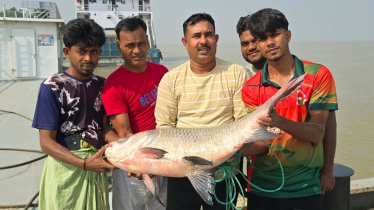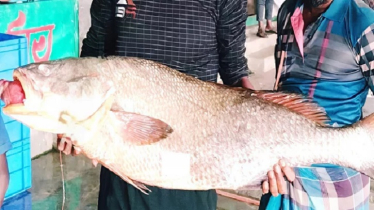
As part of the Sustainable Coastal and Marine Fisheries Project (SCMFP) under the Department of Fisheries, 25 shrimp farmers from Dumuria upazila in Khulna visited a cluster in Keshabpur upazila of Jeshore on Monday for an experience-sharing program. The visit aimed to help farmers gain hands-on knowledge of improved freshwater prawn (galda) farming methods and management practices.
The primary objective of the visit was to learn from successful shrimp farmers about advanced cultivation systems, pond management, and business planning. Upon arrival, the visiting team was warmly received by Senior Upazila Fisheries Officer of Keshabpur, Sudip Biswas, and his staff.
The delegation was led by Dumuria’s Senior Upazila Fisheries Officer Sohel Md. Zillur Rahman Rigan, Assistant Fisheries Officer K.M. Mohsin Alam, Marine Fisheries Officer Pronab Kumar Das, and Antima Goldar, along with several field-level officials.
During the visit, the farmers toured the Gaurighona Shrimp Cluster-1 and the semi-intensive galda farming project area in Keshabpur—recognized as a successful model for sustainable shrimp cultivation. Farmers from both clusters engaged in interactive discussions, sharing practical experiences, farming techniques, and management strategies.
The visiting farmers also observed field-level activities, including net demonstrations and pond inspections. They expressed satisfaction with the quality and growth rate of the shrimp being produced.
The Gaurighona Cluster follows a semi-intensive “all-male” galda cultivation system using high-quality male post-larvae (PL) supplied by FishTech. The model emphasizes biosecurity, increased water depth, regular monitoring of water quality, optimal feed management, and scientifically controlled stocking density.
Farmers including Md. Shafiqul Islam, Md. Tuhin Sheikh, Md. Suman Sheikh, Sabur Molla, Momtaz Begum, Asma Begum, and Aklima Begum exchanged insights on cultivation methods, cost-benefit analysis, risk management, market linkages, and future expansion plans.
According to the Department of Fisheries, shrimp in the cluster have reached an average weight of 25–30 grams within just 83 days—significantly faster than conventional methods. This achievement has boosted productivity while reducing cultivation time and risk.
Khulna Divisional Director Md. Jahangir Alam, Senior Fisheries Officer of Keshabpur Sudip Biswas, Dumuria Press Club General Secretary and Cluster President Sheikh Mahtab Hossain, Marine Fisheries Cluster Officer Md. Tarikul Islam, along with several officials and local farmers, were present during the visit.
Speakers noted that replicating the Gaurighona model in other shrimp-producing regions, particularly in Khulna, could potentially double or even triple production, enhancing farmers’ income, creating rural employment, and increasing shrimp exports.
Participating farmers said the visit provided them with a clearer understanding of modern galda farming technologies and management practices. They expressed interest in adopting all-male PL stocking, improved nursery systems, biosecurity measures, and semi-intensive pond management at their farms.
They also urged the Department of Fisheries to continue organizing similar training and exchange programs in the future. Officials and participants alike emphasized that such practical, educational initiatives are vital for building a sustainable and commercially viable shrimp sector in Bangladesh.





